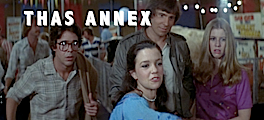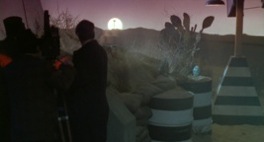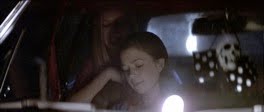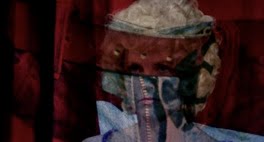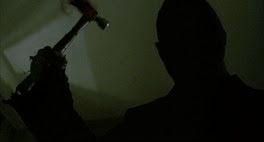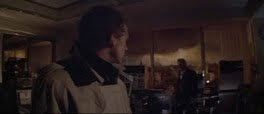2. I realized, projected in all the burnished and darkened-hue glory of a 35mm print, musical score a booming texture rather than a chintzy ear bud tinkle, that Texas Chainsaw Massacre 2 can be in parts as serious and musical and operatic as Hooper's crowning balletic work Spontaneous Combustion (Texas Chainsaw 2 is a prophetic, fluid Wagnerian opera).
3. Despite being a horror-comedy, yes, there is no farce: a constant grim and contemplative dramaturgy underlies every scene, the over-the-top qualities that are commonly perceived but a layering over Hooper's elegant and symbolic cinema, which finds its inlet into the material through an understanding of the film's deeper poignancy. From Stretch and Lefty's low-key - but characterized by struggle - pair of scenes together to Stretch's subtle arc as protege of Lefty's avenging activism ("They live on fear, they live on fear, they live on fear..." is Lefty's mantra which Stretch repeats when suddenly thrust into the front lines), to L.G.'s deeply touching role as innocent and slaughtered lamb (more on this later, plus a thorough shoe-eating), even the admittedly over-the-top Texas Chainsaw Massacre 2 is a shockingly sober and despairing portrait of actual characters - either despairing victims or the politicized poles of insane and unflappable figureheads: the craven capitalists or the delusional Holy Crusader, lashing out at the singularly American moral offenders with little idea of the expansive history of endless savagery and bloodshed he and his enemies wholly share between them.
4. I realized upon this re-watch how potently TCM 2 evokes ideas of social quagmire. Lefty's apparent notoriety, his being coddled and humored by the realist powers-that-be (the Texas detective's triumphant-exasperated aside, "Remember the Alamo, cowboy..." takes a piss to solidarity), and the spectacle of discord in the powerful ranks attracting the gawks of the regular joes in the clean-up crew suggest an all-too-grounded history of banal struggling against a stuck system (though it becomes clear our anti-hero Lefty is no less unstuck from manias characteristic of the decline of the American empire). The Texas Battle Land amusement park is itself an expression of ambivalence, covered in confused murals and statues, where all battling parties are greedy, coveting, self-serving or self-deluding (Drayton the first two, Lefty the latter two), and such memorial places are just false structures covering blood and grue, bones, and our own moral decay. Where Lefty fails in political clarity - hypocrisy on top of hypocrisy, his quaint fanaticism versus Drayton Sawyer's leveling rationality - then only Exit signs provide a beacon of political right-mindedness.
5. How powerful is seeing assholery piled on top of assholery, as we see the joke-glasses-wearing jerk in the opening scene casually loading bullets into a series of the United States's biggest dick moves? How slightly sad is, after being rebuked by Lefty for a wish to do something important, Stretch immediately puts her charming radio host hat back on to cover the thoroughly frivolous and flag-waving story of a regional chili competition? How slightly sad, in the immediately next scene, as Lefty parks in front of the chainsaw store, is Lefty dialing past Stretch's radio station in his car, her voice filling the air with her routine pabulum as if their fervent face-off never happened?
6. The grim dramaturgy is made always apparent through a constant litany on the ills of the world and the divergent philosophies and desires of its people. Hooper and L.M. Kit Carson lament the lost father-daughter relationship between Stretch and Lefty from their original conception, but the simple ideological symbiosis subtly created between them in their two scenes together is more than enough, pulled seemingly from thin air by dint of Hooper's glass floor for eloquent cinema and textured portrayals. How hard these lines hit in that first, quietly urgent scene between them in Lefty's hotel room: "You saw it?" "No, but I heard it..."; "I DJ this dumb show up in Burkburnett..." (said after we've been made so much to love it!); "You're going to get in my way. Don't you get in my way..." "No, I'm already right in the middle of this."; "I've got a perfect willingness to die... That gives me a moral on these bunch of mad dogs" (the "willingness to die," an anti-materialist sentiment that is nevertheless more defeatist than it is progressive).
7. The litany of worldview continues on with Drayton Sawyer's babbling business-minded aphorisms. Hooper's films often find themselves littered with assortments of cruel turns-of-phrase and throw-away world-weary colloquialisms, evidence of Hooper's anarrative wish to tap into the nerve of a dysfunctional, unfair world in all his works. See the twisted folk homilies in The Texas Chainsaw Massacre and The Funhouse, Judd's mumbling primitive justifications in Eaten Alive, Chevalier's entitled cynical postures in Night Terrors, and the hard-bitten class-speak - from both the proletariat and the bosses - in The Mangler.
8. No filmmaker has created as lush and inventive a slasher film lurk-and-stalk sequence as the pre-Chop Top build-up once Stretch is alone in the K-OKLA station.
9. I concede rightness to my friend Matt, of Cinemachine, and, of course, Hooper and the TCM 2 producers, in regards to my previously adamantly expressed opinion that the final cut dropped the ball in excising the "Night Hunt" deleted scenes (in which the Sawyer brothers massacre a football posse and Joe Bob Briggs in cartoonish fashion), while also expressing my intense dislike for the scenes in the meat shed involving the skinned L.G., which I deemed "horrendously inane," suggesting a better film by swapping the two sequences, one for the other. In line with my higher opinion of the film now, I will say that they are right and I am wrong, and that the film is as it should be.
I have a certain taste for didactic politics in films - you know, Godard and Straub and the like - so the pungent and sociologically abrasive "Night Hunt" scenes appealed to me, while the seemingly distended sentimentality of that whole meat shed sequence (Leatherface's childlike acts, L.G.'s reappearance) seemed at odds with the black comedy I perceived.
But this rewatch greatly pushed the film's much more consistent poignant aspects. This is not Hooper's novel attempt at a riotous black comedy - while satire and black comedy is there, in actuality, this film is hardly different from Hooper's other films, in its intent to be taken seriously and felt seriously as an aesthetically and emotionally inquisitive film: as I've described, the opening act rings with deeply felt political grimness in the catching of sounds of atrocity on the airwaves; the logic of Lefty's 14-year-old crusade against barbarianism being undermined by the inundation of barbarianism into the region (the frenzy of a football weekend) is suddenly too gross for a sensitive soul to bear; Chop Top's violence with the hammer accompanied by the call of "Incoming mail!" shows there is little benign about the kitsch of war; Stretch's bid for legitimacy takes on extra poignancy, as does her almost brainwashed sense of duty to combat the Sawyers (first she faces Leatherface with the incredibly daring sexual ploy of bringing him to orgasm with the bet it might remove the wind from his murderous sails, then, with catatonic abandon, she insists on following the Sawyer truck after they've left the radio station, unbeknownst to her that her reckless activism and involvement has been at the cost of L.G.'s life). Her newfound purposefulness is in fact another tragic ambivalence: it is part admirable, part a corrosion of the innocence of non-involvement.
As a film of genuine poignancy, then L.G.'s benevolent return as a selfless corpse (he effectively becomes the only selfless person in the film, his pure selflessness made even more overwhelming by the fact he has literally been stripped of his face), and then Stretch's restoration of his face - allowing this non-embroiled, neutral, thus unimportant individual his dignity in the middle of it all - becomes shockingly moving. So, the farcical Night Hunt scenes are in fact less in line with the rest of the film - they would be sudden segments of spoof in a film that I realized holds as much seriousness in its bones as it does cult pleasure.
10. Despite this being Hooper's most comic, over-the-top, and gory film, providing pleasurable thrills on all those fronts, the film's scenes suddenly take on their correct somber, poignant bent when paying attention to Hooper's complete projected vision, where every scene is imbued with musical decision and weighty cinematic-allegorical soul, completely typical of the elegant Hooper work.
11. Hooper is clearly one of the most astounding film artists. The gory The Texas Chainsaw Massacre 2 is a film one would perceive to be easy to lose into cheapness and crassness, but it is in fact constantly emboldened by the opposite of those things.
At this point, where Texas Chainsaw Massacre and Eaten Alive are the most striking of primal screams, The Funhouse enigmatic and powerful, Lifeforce and The Texas Chainsaw Massacre 2 prove genre fare masterstrokes of the richest if imperfect sort, The Mangler and Night Terrors less salutatory but no less richly ambitious, Eggshells and The Heisters and a "Peter, Paul, and Mary" documentary empirical proof of a formal experimenter of boundless aesthetic interest and abilities, and Spontaneous Combustion maybe being one of the most tender and beautiful films in existence (finally, Dance of the Dead and Poltergeist suggest no slouch), then I simply must ask: may we see Djinn now? No matter how it turns out, it is simply tantalizing to ask: what else can he possibly offer us now from his inexhaustible and variable sleeve, Hooper, our most inexplicably soulful filmmaker? His first foreign language film, I can give you that.
JFB 9/15/2013





































